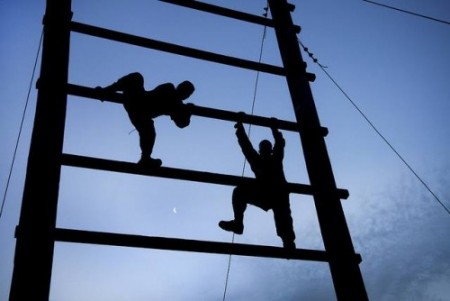
Parties have changed over the past few decades, transitioning from “stand around talk” get-togethers to the sort of experience where people expect to be active and have fun.
That’s what makes inflatable obstacle courses such a good choice for large gatherings of family, friends, neighbors or co-workers. They are a safe, fun way for party goers to challenge themselves against an amazing variety of courses, as well as against an opponent.
The expansion of obstacle courses into parties is an extension of the growing popularity of such courses, which once were familiar only to Olympians and those who had gone through a military boot camp.
Interest in the sport has picked up thanks to some world famous courses, many of which can be seen on television programs that turn obstacle courses into a content between individuals and teams.
Where Did Obstacle Courses Start?
The idea of competing to see who could get from point A to point B the fastest got started in The Olympics, when contestants ran (naked, by the way) in the Stadion competition, basically a 200-meter dash on packed earth. The first winner, way back in 776 BC, was Coroebus of Elis.
Later, the Steeplechase run was invented, featuring water hazards and barriers that runners must leap. But it wasn’t until the 1980s, with the Tough Guy competition, that obstacle courses were used in endurance events.
Tough Guy
This competition, which is still held every year in England, continues to bill itself as the hardest of all the obstacle course competitions. Considering that some of the contestants have been cut, bruised and even shocked by electricity, it’s hard to argue against them.
Obstacles include climbing through mud under barbed wire, getting over wooden barricades walls of fire, and diving into a freezing lake. About 5,000 people try the course every year, but about a third of those never make the finish line, according to The Daily Mail.
Here are some other popular, perhaps last harrowing, obstacle courses.
Tough Mudder
Designed for teams, Tough Mudder is a 10 to 12-mile course that puts the focus on teamwork and physical strength. The course – first developed by two Harvard Business School students – tests physical endurance and also utilizes obstacles that evoke basic human fears about fire, water and heights.
The contest prides itself on being more about camaraderie than race time. On the Tough Mudder site, there are a list of pledges for participants, including: teamwork and camaraderie before course time; “I do not whine – kids whine”; helping others complete the course and overcoming all fears.
Most Tough Mudder events, which are held around the world, features 20 to 25 obstacles.
Wipeout Obstacle Course
This Wipeout game show has, all by itself, raised interest in obstacle courses in general. The show asks contestants to work through a large obstacle course. Some of the obstacles include the wrecking balls, sweeper and the tumble tubes.
Many have names as elaborate as the obstacles themselves, including “A Bridge Too Far,” “Big Balls with Hammer Motivator,” “All America BBQ Blitz” and “The Beavers and the Beaverettes.”
Some events have replicated the game show course. There are Wipeoutrun events in various places that include obstacles inspired by the show.
American Ninja Warrior
Another example of a television show taking the obstacle course idea to the extreme. The show has become so big that qualifiers are held around the country, with winners facing off in a final competition. That final competition, held in Las Vegas, features a four-stage course based on the extremely difficult (to say the least) Mt. Midoriyama course in Japan.
The American show is based on a Japanese show “Sasuke” with a similar format. “American Ninja Warrior” features contestants who must get through a series of obstacle courses such as the cataract climb, quintuple step, prism tilt and cone maze.
Whatever becomes the new most popular obstacle course, it appears that the obstacle course is here to say as a competitive event – both on television, in live events and at a backyard party near you.

